The Gulflander is an Australian passenger train, running 151 kilometres from
Normanton to
Croydon in the Gulf Country of northern Queensland. Often described as 'a train from nowhere to nowhere', the line was completed in 1891 and was never connected to the rest of the Queensland Rail network although it has always been owned and operated by Queensland Rail. The nearest part of the Queensland Rail network is 190 kilometres away at
Forsayth. The service runs once per week to
Croydon on Wednesdays and returns to
Normanton on Thursdays. Shorter charter
services on most other days are also available.
The northern terminus of
Normanton is located on the
Norman River, and served as a port for cattle and gold mining. It was planned for the line to be extended to
Cloncurry to provide an inland route for the cattle country along the route, but after the discovery of gold at
Croydon the decision was made to build a station there instead.
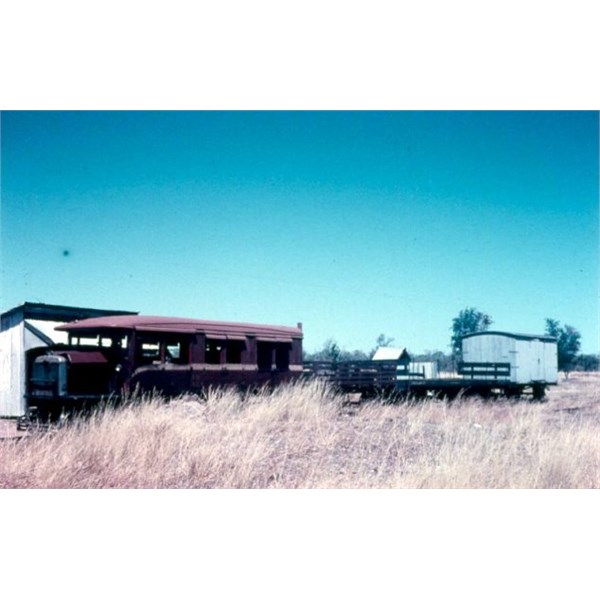
The Gulf Lander in 1954
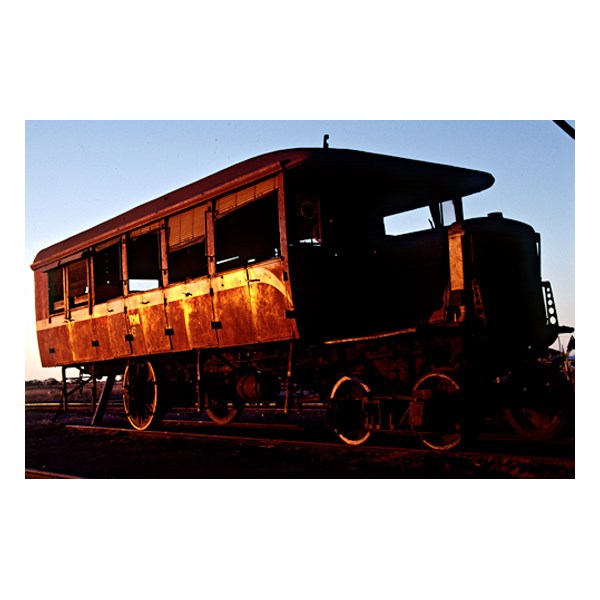
Old Gulflander, Normanton, Gulf Country, Solo MTB Tour 1988
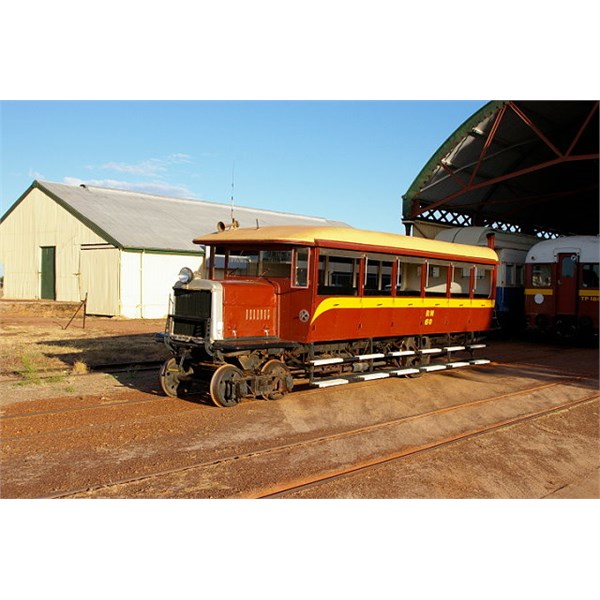
RM60 at Normanton in May 2008
Construction began in 1888. The line was constructed in an unusual manner, with hollow steel sleepers packed with mud to avoid the need for track ballast. This method of construction also meant that the line was not subject to damage during frequent flooding during the wet season, with most of these original sleepers still in place.
Steam locomotives were used until 1922 when diesel railmotors were introduced. By 1974 the line was under the threat of closure, earning just $3,340 in revenue but costing approximately $63,800 to maintain. Today the line exists as a tourist attraction, and is said to be more an adventure than a train ride. The train crews are qualified guides and will stop the train and talk about points of interest. The present three-car railmotor set is known as "the old Tin Hare".
In the 1870s and 1880s, private groups and individuals were promoting the concept of a transcontinental railway across western Queensland to the Gulf of Carpentaria. One of these concepts was for a private railway from
Roma to Point Parker. This received the backing of the government of Sir Thomas McIlwraith, the then Premier of Queensland. Subsequently the land grant and privately built railway collapsed with the fall of his Government which would have served
Cloncurry and the mineral fields of the district en route.
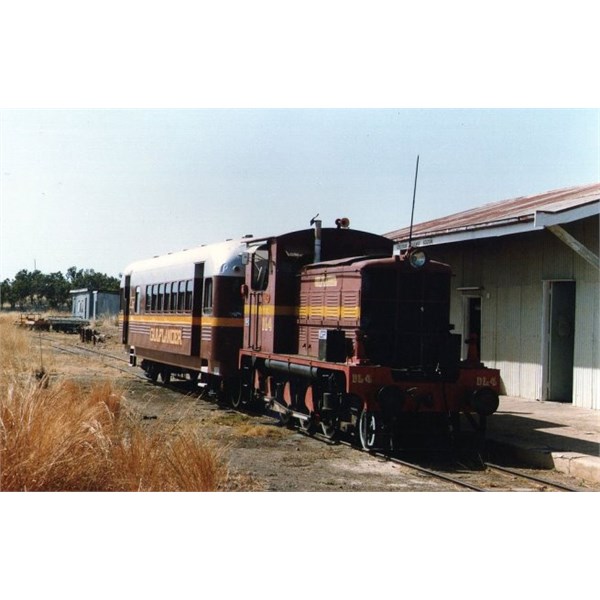
DL4 at Normanton in July 1991
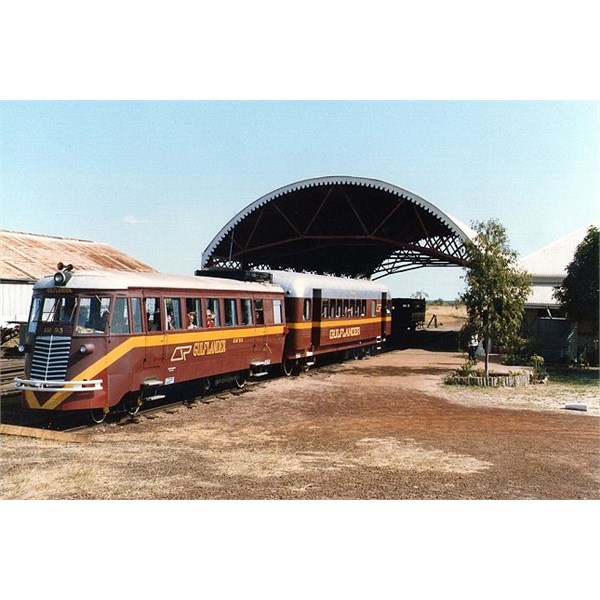
RM93 and trailer about to depart Normanton on its weekly run to Croydon in July 1991

gulflander-logo
In 1885 a survey was undertaken for a railway between
Cloncurry and
Normanton, after a Glasgow based
Cloncurry Copper Mining and Smelting Company decided to develop the
Cloncurry mining field. The government decided to proceed with a railway from the port of
Normanton, to
Cloncurry and an order was placed for 160 kilometres of rail.
The first section towards
Cloncurry was approved on 16th November 1886. Yet whilst these grand plans were being enacted by Parliament in
Brisbane, other events were already overtaking the future direction of the railway. The discovery of gold at
Croydon in November 1885 saw a hurried change in direction of the railway with
Normanton quickly becoming the port for the new bonanza. The gold field was rich and travel difficult in the hot dry conditions. The
population by 1887 reached 6000.
Parliament agreed to amend the already approved plans so that the first few
miles would be common whether the railway went to
Cloncurry or
Croydon. A budget was approved in October 1887 for construction of the first sixty-eight kilometres of railway to
Croydon. Although the government still maintained that a railway would be built to
Cloncurry. The first twenty one kilometres of the
Normanton-
Cloncurry railway was deviated for the new destination of
Croydon. The rest of the railway to the goldfields was approved by parliament on 28th May 1889.
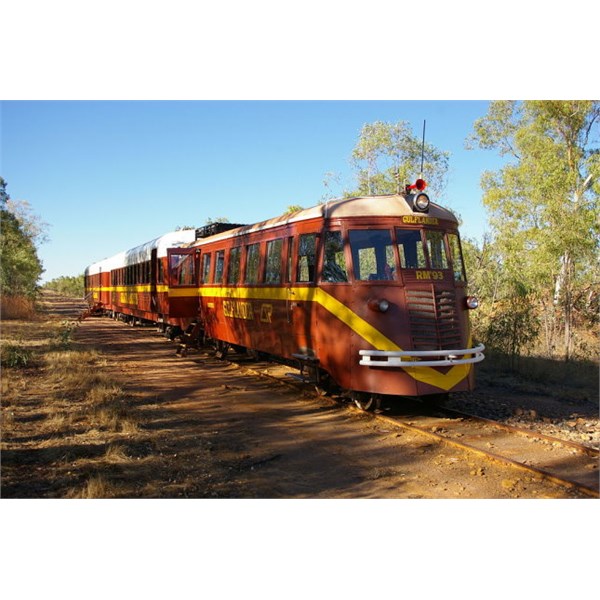
RM93 at Golden Gate near Croydon
The first rail on the
Normanton-
Croydon railway was laid in 1888. To lower construction costs and to defeat the termites of the Gulf, specially patented steel sleepers were used, designed by QR Inspecting Surveyor George Phillips.
Phillips was a civil engineer, authorized surveyor, and explorer, who had also surveyed the towns of
Normanton and
Burketown. In 1878, Phillips joined the Railways Department as an Inspecting Surveyor. In 1886, Phillips retired from the Public Service, establishing himself as consulting Surveyor and Civil Engineer.
From 1888 to 1891 Phillips supervised the construction of the
Normanton-
Croydon Railway. Mrs Archibald Smith Frew laid the first sleeper of the main line to
Croydon on 2nd July 1888. The chief assistant engineer was Archibald Smith Frew who later went on to construct the Almaden-
Forsayth line. Less than four of the 151 kilometres were protected by side drains and only small amounts of ballast were used, despite the railway carrying normal rolling stock over some of the ?most flooded and rotten country in Australia?.
The sleepers were packed with earth when they were laid, giving extra weight and stability, and the rails were bolted to the sleepers which meant they could not move nor work loose in the same way as dog-spikes used in timber sleepers. In flood time
water simply passed over the top. Except for the cost of the steel sleepers (more expensive than timber) it was an exceedingly cheap method of construction suitable for light traffic frontier lines. The railway opened in three stages with the first to Haydon being completed on May 7, 1889, then Blackbull on December 15, 1890 and finally to
Croydon on July 20, 1891. Golden
Gate, near
Croydon, was one of the richest production centres on the
Croydon gold field.
The initial train service was worked by steam train four days a week, being reduced after 1894 to three. Every three weeks the timetable was varied to coincide with the arrival of the mail steamer to the Port of
Normanton. In the early twentieth century, Special trains were run for picnic events, race meetings and even a suburban service from
Croydon to Golden
Gate. The last steam train ran in 1929. Since 1930, the service has been exclusively run using railmotors.
The expense and difficulties of maintaining a steam service, combined with the closure of the
Croydon goldfields, saw the Queensland Railways investigate cost saving measures.

RM14 Railmotor
In 1922, the first internal Combustion engine railmotor (RM14) arrived in
Normanton. This was a converted Panhard Levassor road wagon.
The 22 horsepower petrol Panhard-Levassor worked hard during its 93 years in operation clocking up more kilometres than most other railway engines of her time. It was originally created as a car engine before it was converted into a railmotor in
Ipswich in 1918. The railmotor reflected a Panhard-Levassor road wagon weighing 4 tons with a capacity of 10 passengers and a driver.
RM14 on 2200km journey
.